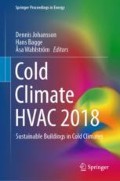Abstract
High temperature district heating systems are connected to high losses, therefore, new district heating systems have lower temperatures. In Zero Emission Neighborhoods (ZEN) the heat demands are reduced and 4th generation district heating (4DH) solutions opens as a solution to provide the heating demands with lower transmission losses. However, district heating (DH) has to cover demands in new, renovated and old buildings connected to the supply. Therefore the supply temperature cannot be reduced without further consideration. One strategy to cover demands is to connect older buildings with higher temperature requirements on the supply pipe and the new/renovated buildings on the return pipe. A second strategy is to use local boosters (at building level), e.g. heat pumps or boilers, in a low temperature DH network, to supply the buildings that require high temperature supply (old radiators, leaky envelopes…). Either way, the fundamental constraint is what is the minimum heating supply temperature in different building types? In turn, this holistic approach will map the minimum DH supply temperatures that the heating demands of all the buildings forming the ZEN can be covered. This paper analyzes for the case study of residential buildings in Norway according to the archetypes defined in the Tabula/Episcope projects. The focus of this paper is on single-family houses of the seventies. Each case is subdivided based on energy performance (original, standard renovation and ambitious renovation). The buildings were simulated in IDA Indoor Climate and Energy (IDA ICE). The effect of renovation on the achievement of thermal comfort levels compared to minimum supply temperature is studied.
Access this chapter
Tax calculation will be finalised at checkout
Purchases are for personal use only
References
H. Brattebø et al., Typologier for norske boligbygg. Eksempler på tiltak for energieffektivisering (2014)
N.H. Sandberg, I. Sartori, H. Brattebø, Using a dynamic segmented model to examine future renovation activities in the Norwegian dwelling stock. Energy Build. 82, 287–295 (2014)
DiBK, D.f.b., Byggteknisk forskrift med veiledning (TEK10) (2010)
C. Mjønes et al., Potensial- og barrierestudie Energieffektivisering av norske boliger- (2012)
Equa, ed. by User Manual IDA Indoor Climate and Energy (2013)
P. Blom, S. Uvsløkk, Bygg tett! Prosjektrapport 98, SINTEF serie (2012)
M. Brand, S. Svendsen, Renewable-based low-temperature district heating for existing buildings in various stages of refurbishment. Energy (2013)
T.H. Dokka, C. Grini, Etterprøving av bygningers energibruk. Enova (2013)
Acknowledgments
The authors gratefully acknowledge the support from the Research Council of Norway and several partners through the Research Centre on Zero Emission Neighbourhoods in Smart Cities (FME ZEN). Grant number 257660.
Author information
Authors and Affiliations
Corresponding author
Editor information
Editors and Affiliations
Rights and permissions
Copyright information
© 2019 Springer Nature Switzerland AG
About this paper
Cite this paper
Alonso, M.J., Sartori, I. (2019). What Is the Minimum District Heating Supply Temperature in Residential Buildings in Norway?. In: Johansson, D., Bagge, H., Wahlström, Å. (eds) Cold Climate HVAC 2018. CCC 2018. Springer Proceedings in Energy. Springer, Cham. https://doi.org/10.1007/978-3-030-00662-4_26
Download citation
DOI: https://doi.org/10.1007/978-3-030-00662-4_26
Published:
Publisher Name: Springer, Cham
Print ISBN: 978-3-030-00661-7
Online ISBN: 978-3-030-00662-4
eBook Packages: EnergyEnergy (R0)

